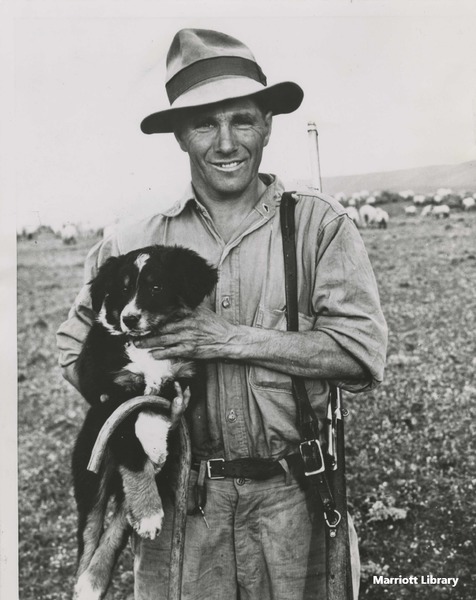Dublin Core
Title
Description
In late nineteenth-century Utah, the term “Basque” became synonymous with “sheepherder,” and many Basque men developed reputations as reliable and skilled herdsmen. Their work in the remote landscapes of rural Utah was lonely, but the isolated herders found winter homes in Basque-only boarding houses located in towns such as Price, Ogden, and Salt Lake City. It wasn’t long before this small handful of boarding houses became community centers that supported the traditions and culture of Basque country.
When the Hogar Hotel opened in Salt Lake in 1927, it became a home for Basque immigrants working throughout rural Utah. Owned by John and Claudia Landa, the Hogar Hotel was a haven for Basque sheepherders in need of housing and relaxation during the winter months. As Basque immigrants themselves, the Landas took pride in creating a familiar atmosphere for local Basques, who used the business as a restaurant, meeting place, and cultural center. To register with the hotel, you needed to be Basque and speak the language -- or, at least, Spanish or French. Seen by many community members as honorary grandparents, the Landas served traditional homemade meals and played Basque records on the jukebox.
Winters spent in the Hogar Hotel were starkly different from the months spent sheepherding. Traveling in a small sheepwagon, young Basque men would range for hundreds of miles throughout Utah during seasonal grazing cycles. The work was mentally grueling and isolating. Without the company of anyone but their dog, horse, and flock of sheep, many men turned to the rural landscape to tell their stories. Their tree carvings, or arborglyphs, were a way to share news, grazing information, or simply mark the passage of time. There are over 27,000 documented tree carvings attributed to Basque sheepherders throughout the American West.
By the 1960s, the sheepherding industry waned, and the Hogar Hotel closed its doors. However, these boarding houses served a lasting role in protecting Basque traditions. Food, music, and a familiar language helped connect new immigrants, families, isolated sheepherders, and elderly community members, creating small ethnic enclaves that preserve Basque culture today.
Creator
Source
_______________
See: “The Hogar Hotel: S.L. Basque Home Closing Its Doors,” The Salt Lake Tribune, March 27, 1977; Eileen Hallet Stone, “Living History: Basque Immigrants Made their Livelihoods as Sheepherders,” The Salt Lake Tribune, March 8, 2012; Josie Manwill, “Isolation Led to Basque Hotels in Ogden,” Intermountain Histories; “Byways and Backwaters,” Park Record, December 21, 1978; Lewis S. Hills, “House (Hogar Hotel),” Utah Division of State History, Preservation Section; Jim Connors, “Basque Sheepherders in the American West,” Friday Footnote, October 22, 2021; JoAnn Blalack, “Basque Sheepherder Aspen Carvings,”National Park Service, April 22, 2021; Iker Saitua, “How Basques Became Synonymous with Sheepherders in the American West,” Zocalo, July 10, 2019; John R. Bopp, “Basque Sheepherders’ Arborglyphs in the Far West Are a Heritage that is to be Preserved,”About Basque Country, April 10, 2023; “Basques in the American West,” The Basque Museum and Cultural Center.

